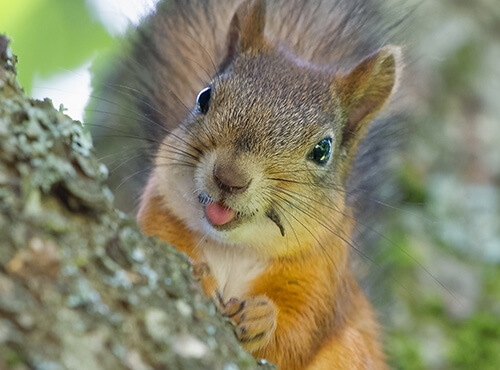
Wildlife Exclusion Services
Wildlife exclusion is Critter Control Canada’s long-term solution to keeping animals out of homes and commercial properties. Wildlife exclusion can be used as a preventative measure, or once an animal has been removed. This service also exemplifies our commitment to both a humane and eco-friendly solution, as it simply keeps animals from needing to be removed in the first place and ongoing infestations.
Wildlife invasions are becoming more frequent in Canada because of its record population growth. This level of growth necessitates the development of new housing, roads, and potentially new schools, hospitals, and other commercial services. As urban areas expand, it’s increasingly likely that the sprawl will impact wildlife habitats and put human populations closer to these animals than before.
Problems Associated with Invading Wildlife
When wildlife enters into homes and businesses, their main reasons are to find resources like food and shelter. In the course of living in attics, chimneys, basements, or crawlspaces, they expose people to disease and parasites and create structural damage. This damage is costly and often not covered by insurance because it is deemed preventable. Wildlife proofing denies animals the ability to enter, thereby greatly diminishing the chances of damage in the first place.
Without exclusion methods, a home is vulnerable to the following:
- Rodents such as mice and rats that gnaw wood and floorboards, chew on electrical wires, soil insulation, and contaminate food with the feces and urine they leave in pantries, drawers, and on counters.
- Raccoons are capable of tearing a hole in a roof to gain entry. Once inside an attic, it will tear up insulation and soil a specific area in the area repeatedly.
- Backyard animals such as skunks, opossums, and chipmunks will create a den under a porch, deck or shed, or dig tunnels beneath the lawn. These activities can damage foundations, uproot pathways, and damage electrical wires or pipes coming into a home. These animals will also dig up plantings and damage trees and shrubs.
Wildlife exclusion is a humane way to wildlife-proof one’s property. It emphasizes prevention while employing non-lethal, non-toxic, and non-invasive ways to control wildlife.
Our Humane and Expert Approach to Wildlife Exclusion
Since our inception in 1983, Critter Control has been dedicated to humane wildlife exclusion by using innovative, integrated methods to provide family and environmentally friendly ways to keep critters away. Each situation is unique, so we work with customers to create a plan to exclude or remove and then exclude wildlife. This minimizes the risk of future infestations and costly repairs to the damage they create.
Anyone’s home or business is susceptible to nuisance wildlife problems. But wildlife exclusion is one maintenance task that is best taken off your plate for a few reasons:
- Animals can get aggressive when confronted, especially if they have young. Getting scratched or bitten by even a small animal that could carry rabies is too great a personal risk.
- Handling wildlife feces and urine can lead to serious health issues when not dealt with properly.
- Some animals are adept at avoiding exclusion techniques and may easily find other ways to enter your home or business.
Critter Control Canada specialists are highly trained professionals who know all the ways wildlife can find to get inside a structure and, therefore, can ensure all vulnerable gaps have been sealed.
Don’t wait until wildlife invades; use our Critter Control office finder and let us create a plan to give you peace of mind.
Expertise in Wildlife Exclusion
The only thing more resourceful than animals invading your space is a Critter Control Canada technician. Our comprehensive and continuous training ensures that we continue to be a leader in the wildlife removal and exclusion industry.

Exclusion Techniques
- Chimney caps that prevent wildlife from nesting or falling inside
- Sealing entry points in roof, soffit, and fascia spaces and intersections
- Plumbing, roof, oven and bathroom exhaust vent covers to keep animals out
- Repairing and reinforcing holes in house siding
- Installing hardware cloth around the base of porches and decks
- Removal of tree limbs overhanging the roof that provides animals with easy access
- Installing exclusion architecture to keep birds from roosting
Benefits of Humane Wildlife Exclusion Methods
- The wildlife around us are as much a part of our ecosystem as we are and deserve to be treated with care and respect.
- Humane exclusion works because most animals are adaptive, and when one area becomes inhospitable to them, they will move on to what they perceive as a better and easier location.
- Just like people, many animals are also part of communities. It can upset the balance of nature when they are harmed or relocated to areas where they should not be.


Training and Expertise
- Critter Control has been putting wildlife humanely back in its place for more than forty years.
- Our technicians receive continual training throughout their tenure.
- We have developed an internal credentialing system. Our technicians that pass these rigorous training measures are given the designation of certified wildlife specialists. It’s our way of supporting and encouraging our staff to excel in their work.
Contact Critter Control Canada Today
Critter Control Canada is a leader in wildlife control and wildlife exclusion throughout the country, taking the stress off of families and animals when urban and suburban living brings things too close for comfort. Make us your go-to wildlife removal company for expert and humane removal, exclusion, and repair.
We back all of our services with our animal exclusion guarantee because we know that our wildlife exclusion techniques keep animals out of homes and businesses. Call us at 833-965-2881 to locate a Critter Control nearest you.